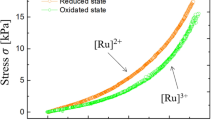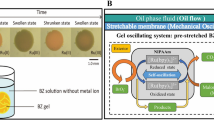Abstract
Hydrogels are fascinating and useful in that they can show large volume changes in response to various stimuli, such as temperature or chemical environment1. Here we report the peculiar observation that chemically crosslinked hydrogels that normally expand owing to a change in electrolyte pH can be made to shrink in certain circumstances. Specifically, these hydrogels contract when tested at a constant compressive force and subjected to a pH change that causes expansion in the absence of the applied load. When tested under tension, the gels always expand. Although the effects of external stress on the swelling of gels is known2,3,4, the concomitant change in gel mechanical properties during pH switching was found to be a more dominant effect in our studies. However, existing mechanical models5,6 used to predict dimensional changes in actuator materials could not explain both the tensile and compression results. In addition, we show that the friction between metal plates of the apparatus and the gel is a key factor in explaining the contractile actuation under compressive loads. The observations reported in this paper are important for the successful design and use of hydrogel actuators in devices such as valves for microfluidics.
This is a preview of subscription content, access via your institution
Access options
Subscribe to this journal
Receive 12 print issues and online access
$259.00 per year
only $21.58 per issue
Buy this article
- Purchase on Springer Link
- Instant access to full article PDF
Prices may be subject to local taxes which are calculated during checkout



Similar content being viewed by others
References
Ilmain, F., Tanaka, T. & Kokufuta, E. Volume transition in a gel driven by hydrogen-bonding. Nature 349, 400–401 (1991).
Treloar, L. R. G. The swelling of cross-linked amorphous polymers under strain. Faraday Trans. 46, 783–789 (1950).
Budtova, T. & Suleimenov, I. Swelling behaviour of a polyelectrolyte network under load. Polymer 38, 5947–5952 (1997).
Vervoort, S., Patlazhan, S., Weyts, J. & Budtova, T. Solvent release from highly swollen gels under compression. Polymer 46, 121–127 (2005).
Spinks, G. M. & Truong, V.-T. Work-per-cycle analysis of electromechanical actuators. Sens. Actuat. A 119, 455–461 (2005).
Spinks, G. M., Liu, L., Zhou, D. & Wallace, G. G. Strain response from polypyrrole actuators under load. Adv. Funct. Mater. 12, 437–440 (2002).
Osada, Y., Okuzaki, H. & Hori, H. A polymer gel with electrically driven motility. Nature 355, 242–244 (1992).
Yoshida, R. et al. Comb-type grafted hydrogels with rapid de-swelling response to temperature-changes. Nature 374, 240–242 (1995).
Brannon-Peppas, L. & Peppas, N. A. Equilibrium swelling behaviour of pH-sensitive hydrogels. Chem. Eng. Sci. 46, 715–722 (1991).
English, A. E., Tanaka, T. & Edelman, E. R. Equilibrium and non-equilibrium phase transitions in copolymer polyelectrolyte hydrogels. J. Chem. Phys. 107, 1645–1654 (1997).
Osada, Y. & Hasebe, M. Electrically activated mechanochemical devices using polyelectrolyte gels. Chem. Lett. 9, 1285–1288 (1985).
Kim, S. J., Sang, J. P. & Kim, S. I. Swelling behavior of interpentrating polymer network hydrogels composed of poly(vinyl alcohol) and chitosan. Reactive Funct. Polym. 55, 53–59 (2003).
Beebe, D. J. et al. Functional hydrogel structures for autonomous flow control inside microfluidic channels. Nature 404, 588–590 (2000).
Suzuki, A. & Ishii, T. Phase coexistence of neutral polymer gels under mechanical constraint. J. Chem. Phys. 110, 2289–2296 (1999).
Hirotsu, S. & Onuki, A. Volume phase transition of gels under uniaxial tension. J. Phys. Soc. Jpn 58, 1508–1511 (1989).
Kato, E. Pressure-induced volume phase transition of polyacrylamide gels in acetone-water mixtures. J. Chem. Phys. 113, 1310–1314 (2000).
Nasimova, I., Karino, T., Okabe, S., Nagao, M. & Shibayama, M. Effect of ionization on the temperature- and pressure-induced phase transitions of poly(N-isopropylacrylamide) gels. J. Chem. Phys. 121, 9708–9715 (2004).
Stammen, J. A., Williams, S., Ku, D. N. & Gulberg, R. E. Mechanical properties of a novel PVA hydrogel in shear and unconfined compression. Biomaterials 22, 799–806 (2001).
El-Aguizy, T., Plante, J.-S., Slocum, A. H. & Vogan, J. D. Frictionless compression testing using load-applying platens made from porous graphite aerostatic bearings. Rev. Sci. Instrum. 76, 075108 (2005).
Gent, A. N. & Lindley, P. B. The compression of bonded rubber blocks. Proc. Inst. Mech. Eng. 173, 111–117 (1959).
Whiting, C. J., Voice, A. M., Olmsted, P. D. & McLeish, T. C. B. Shear modulus of polyelectrolyte gels under electric field. J. Phys. Condens. Matter 13, 1381–1393 (2001).
Gong, J. P. & Osada, Y. Surface friction of polymer gels. Prog. Polym. Sci. 27, 3–38 (2001).
Acknowledgements
The authors wish to thank the Australian Research Council for financial support through the ARC Centre of Excellence in Electromaterials Science and the Linkage International project funding.
Author information
Authors and Affiliations
Corresponding author
Ethics declarations
Competing interests
The authors declare no competing financial interests.
Rights and permissions
About this article
Cite this article
Kim, S., Spinks, G., Prosser, S. et al. Surprising shrinkage of expanding gels under an external load. Nature Mater 5, 48–51 (2006). https://doi.org/10.1038/nmat1553
Received:
Accepted:
Published:
Issue Date:
DOI: https://doi.org/10.1038/nmat1553
This article is cited by
-
Characteristics of the creep-induced bending deformation of a PVC gel actuator by an electric field
Journal of Materials Science (2011)
-
On the Motive Power of Chemical Transformations in Open Systems
Journal of Elasticity (2011)
-
Characteristics of pH-sensitive hydrogel microsphere of poly(acrylamide-co-methacrylic acid) with sharp pH–volume transition
Colloid and Polymer Science (2007)



